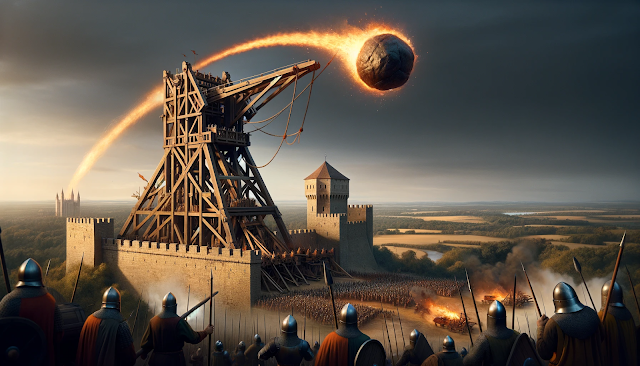Introduction
The trebuchet stands as a testament to the ingenuity of medieval warfare, a siege engine that combined principles of physics with brute force to bring down the mightiest of walls. Developed during the Middle Ages, trebuchets were used to hurl projectiles over great distances, causing devastation that could breach even the most formidable fortifications. Their appearance on the battlefield signaled a shift in siege tactics, from manpower-intensive assaults to calculated mechanical warfare.
The Origin and Evolution of Trebuchets.
The trebuchet's history can be traced back to 4th century BC China, but it was in the 12th century in the medieval West that it found its iconic form. The design evolved from traction trebuchets, which relied on teams of men pulling ropes, to the more powerful counterweight trebuchet. This latter design leveraged a heavy counterweight to launch stones, fireballs, and even diseased carcasses into or over enemy walls with fearsome accuracy and power.
Siege Warfare and the Trebuchet
Siege warfare during medieval times was a grand and gruesome affair, with the trebuchet at the heart of the action. Castles and fortified cities were the epicenters of power, and the trebuchet was the key to unlocking their defenses. It could fling projectiles weighing hundreds of kilograms, effectively demolishing masonry and causing chaos within. The psychological impact was as significant as the physical; the sight and sound of an approaching trebuchet often led to quick surrenders.
Trebuchets Across the World
While most commonly associated with the sieges of Europe, trebuchets found their way across the globe. The Byzantine Empire, known for its innovative military tactics, adopted and refined trebuchet designs. Even the Mongol hordes, under the command of Genghis Khan, employed trebuchets in their conquests, demonstrating the weapon's adaptability to various warfare strategies and proving its worth beyond European borders.
Trebuchets in Famous Battles
Historic battles were often defined by the presence of trebuchets. The Siege of Stirling Castle in 1304 saw King Edward I of England bring a giant trebuchet named "Warwolf" to bear, which ultimately forced a Scottish surrender. The Fall of Constantinople in 1453 featured trebuchets as a crucial component of the Ottoman siege forces, showcasing their effectiveness until the advent of gunpowder-based artillery.
Decline and Legacy
As the Middle Ages waned, so too did the trebuchet. The development of cannon and gunpowder artillery rendered the trebuchet obsolete. Despite this, its impact on siege warfare and medieval society was indelible, influencing military tactics and castle architecture. The trebuchet remains a symbol of medieval martial prowess and a subject of fascination for historians and engineers alike.
Conclusion
The trebuchet's legacy is carved into the stone of the ruins it helped create and in the annals of military history. A marvel of medieval engineering, it exemplifies the period's complex interplay between technology and warfare. Even though its time on the battlefield has passed, the trebuchet continues to catapult through history as a powerful reminder of a bygone era's innovation and the relentless human pursuit of advantage in the face of conflict.

Comments
Post a Comment